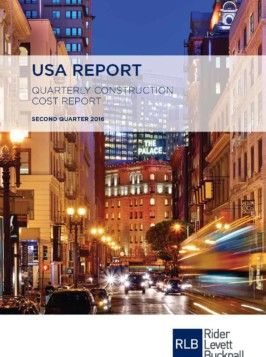July 11, 2016
The Rider Levett Bucknall (RLB) Second Quarter 2016 USA Construction Cost Report states that the number of multi-family units versus single-family units is roughly equal since 2015. The report shows the average U.S. construction cost escalation at a robust 5.7%, with San Francisco and Los Angeles having highest increases.
RLB’s research indicates that housing construction overall has returned to equilibrium, with construction activity now matching population driven demand. The firm also stated that volatility in construction unemployment rates may reflect worker skepticism, over whether the industry will continue to provide stable employment. RLB reported its findings in its newly released Second Quarter 2016 USA Construction Cost Report.
In the report, RLB noted that while construction of single family homes represented about 66 percent of new housing from 2000 to 2011, by 2015 the number of single family units and multi-family units was roughly the same. The report cited a variety of theories that may explain this trend, including a general move towards urban core living in the U.S., rising rents versus affordability, and individual lifestyle decisions.
Current outlook still positive
The firm also noted that after nine straight months of increased construction employment – 239,000 construction jobs were added between July 2015 and March 2016 – industry unemployment reached 8.7%. By May 2016, construction unemployment fell to 5.2%, the lowest level since October 2006, even though 20,000 jobs were lost during April and May.
“Recent increases in construction unemployment, although slight, coupled with housing construction reaching equilibrium with demand, may be a sign that overall construction activity is beginning to level,” said Julian Anderson, President of RLB in North America.
“Although the current outlook is still positive, uncertainties such as the status of the post-Brexit global economy, the stock market, and the upcoming presidential election must be considered to achieve a clear picture of the path forward,” he concluded.
San Francisco and Los Angeles see largest increases in construction costs
RLB tracks construction costs in 12 major U.S. cities. The firm’s research suggests that during the first quarter, the average national construction cost increased approximately 1.4%. Los Angeles (2.4%) and San Francisco (4.9%) experienced the greatest increases. Other locations experienced inflation between about 1.0% and 1.2%, with Chicago, Honolulu, New York, Seattle and Washington DC all experiencing less than 1.0% change in the quarter.
According to the U.S. Department of Commerce, construction put-in-place during April 2016 was estimated at a seasonally adjusted annual rate of $1,133.9 billion, which is 1.8% below the revised March estimate of $1,155.1 billion. The April 2016 figure is 4.5% above the April 2015 estimate of $1,085 billion. The value of construction for the first four months of this year was $334.8 billion, 8.7% above the same period in 2015.
RLB reports on the comparative cost of construction in 12 U.S. cities on a quarterly basis, indexing them to show how costs are changing in each city in particular, and against the costs of the other 11 locations. Together with additional international and national cost compendia, the cost research equips clients with complete and relevant information to assist in key business decisions.
FURTHER INFORMATION:



